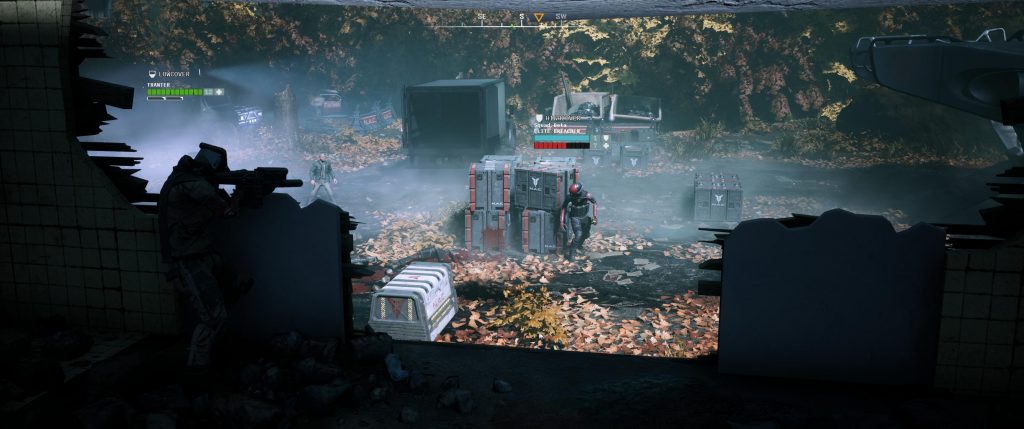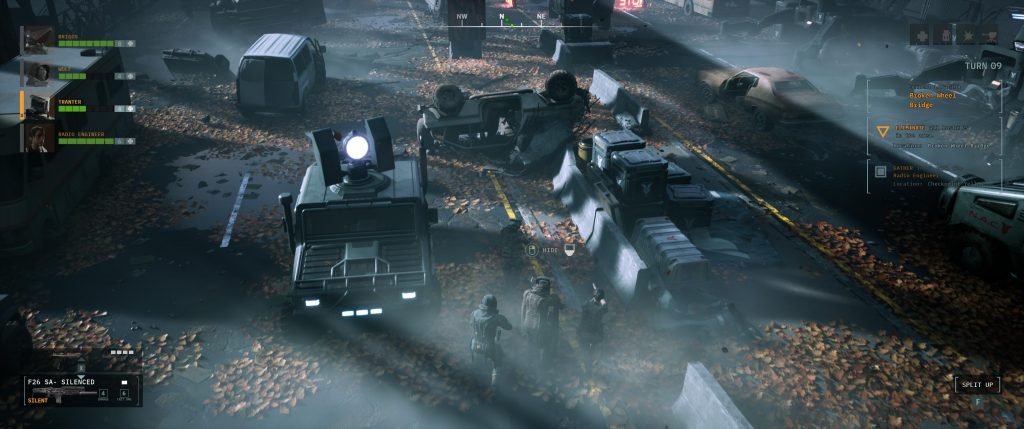
The Bearded Ladies are a Swedish who made an impact last year with the launch of Mutant Year Zero: Road to Eden, a tactical turn-based action game where you controlled a small group of characters that included a mutant pig. I never got a chance to play it, but the reception was pretty good. For their newest game – Corruption 2029 – Bearded Ladies seem to have focused their attention almost purely on the core turn-based action, leaving out the various other elements that weren’t quite so well recieved. That means Corruption 2029 is a very lean game, something which some people might like and others may not. So did stripping away the fat give Corruption 2029 the body of a Greek God, or did it result in something that looks like it just needs about 20 good meals.
Right, so let’s talk about the story: there isn’t one. I think. It all takes place in a dystopian future in 2029 which is obviously a long time away….wait, this is 2020. Jesus Christ. Anyway, America has been devastated by a second civil war, because I guess America is the only place things can happen, and you find yourself in control of a small squad of three robots behind enemy lines. Littering the environments are notes from long-gone civilians, laptops to hack and other little bits and bobs that vaguely fill in the game’s lore, but it’s fair to say that in terms of story there’s really very little given to you, and what you do get is instantly forgettable.

Available On: PC
Reviewed On: PC
Developer: TheBearded Ladies
Publisher: The Bearded LadiesReview code supplied free of charge by the publisher
Your squad gets dispatched to do a variety of basic tasks, from wiping out all the enemies on a map to rescuing a target who then needs to be escorted to a terminal or something.
When you aren’t in a fight the game is played in real-time with you controlling your squad using the WASD keys and the mouse. There’s a hefty dose of stealth at play here because you can click the left mouse button to go nearly invisible, reducing the radius at which enemy units can spot your squad. There’s a lot of benefits to staying under the radar, such as medkits, grenades and explosives that can be picked up and either saved for later or used to help you complete the mission. Plus there’re opportunities to do stuff like hack turrets.
The biggest reason to sneak around like a coward is to setup ambushes. Using silenced weapons it’s possible to actually eliminate individual enemies, or if you watch patrols carefully you can potentially take out a group without everyone else hearing the racket and coming running. However, enemies are also capable of radioing for help so you need to setup your attacks to deal maximum damage or otherwise risk being outnumbered. It’s incredibly satisfying to pick off some guards before setting up some explosives and using them to take out a whole building that a sniper was residing in. Do things right and you can enter combat having already killed off a big chunk of the enemy.
You really do need to make use of all that stealth, too, because the game can be rather unforgiving. One mistake can lead to huge numbers of foes descending on your idiotic arse, and while it’s sometimes possible to brute-force your way to a win it usually just results in you being very, very dead. It forces you to stop, think and execute plans with precision, which I appreciate. Or at least, I appreciate it when I actually get it right, because I have all the planning capability of a certain sponge who lives in a pineapple under the sea.

When you finally jump into a firefight proper the game swaps over to a turn-based system that will be instantly familiar to XCOM veterans. On your turn each of your soldiers gets just two action points to spend on moving, shooting and using abilities or equipment. Smartly, when you hover over a square that you’re considering moving to it’ll display lines of sight to nearby enemies as well as the odds of being able to hit them, because just like XCOM when you attack your success or failure comes down to chance. It’s a system that causes just as much tension as it does frustration. Dramatic hits despite having just a 25% chance are elating, but at the same time missing a 90% shot feels like Lady Luck kicking you in the balls while wearing particularly point shoes. And like XCOM the system can occasionally go a little barmy, giving you weird odds despite standing right next to foes or even declaring you don’t have a line of sight when you clearly do. A little too frequently lines of sight mad no sense for my taste, so hopefully that gets patched.
The occasional weird mathematics aren’t enough to stop the action from being tremendously fun, though. And that fun is augmented through the various upgrades and weapons you earn as mission completion rewards. Your three soldiers have no set class, but each one can be given three implants that grant passive or active abilities, a primary weapon and a secondary. A personal favourite of mine was to equip a sniper rifle, an upgrade that guaranteed critical hits when attacking from a height and an augmented jump ability that literally lets soldiers hurl themselves up onto buildings, even if that means leaping through roofs. I also favoured one of my soldiers touting a shotgun, bolstered armour and a handy ability to barge through walls or into hapless enemies whose lazy Sunday has now been totally fucked up. Now that’s an assault class. Other cool gear includes a mini-gun if you feel like everything in the immediate vicinity is entirely too free of holes.
While I can’t say that the whole upgrade and weapon system gave me the same anguishing choices as in XCOM, the fact that you can unlock and try out everything whenever you like means there’s plenty of room to play around.
It’s just a shame that customization doesn’t extend to your squad’s aesthetics or even their names. In something like XCOM you can rename your goons and tinker with how they look, giving you a sense of ownership that is devastating whenever they die. In Corruption 2029 your three squad members have predefined names and looks. This made me think that perhaps the developers were going to give them distinct personalities, especially since they can’t permanently die – if they do get “killed” in combat they’ll be revived once the fight is over, and if all three are wiped out it’s just a mission failure. But no, they have no personality and are visually damn near impossible to distinguish from each other until you give them different weapons. Even then, at a glance it’s hard to tell which one is which. So why not let us name them and tweak how they look?

The rest of the game’s visuals are pretty solid from a technical perspective, but a bit boring in terms of design. It doesn’t help that the developer’s last game also featured a three-person squad that had mutated animals. By comparison Corruption 2029 is very tame, opting for a much more realistic style with some lovely lighting and a good amount of detail on character models and in the environment. The problem is it’s all rather bland and each the maps look kind of the same. Each location blurs together, and since there aren’t very many maps you’ll be playing them over and over again. This isn’t to say the game is ugly, it just needed more variety in both locations and the items strewn around the environments. There’s only so many times you can see the same buses or tanks before it becomes dull, after all.
You also don’t get as much meat on the bones as you do with something like XCOM. There’s no base building, economic management or anything else of the sort. There’s just a few missions to pick between at a time, meaning none of the insane juggling acts found in XCOM. It’s a bare bones package, in other words, with the main campaign lasting somewhere around 10-15 hours, or a bit more if you fancy completing all the optional medals.
But it’s important to know that Corruption 2029 isn’t asking £40, instead it retails at just £16.99, making it so much easier to forgive the limited maps or the fact that the package as a whole isn’t as beefy as other games on the market. In fact, I’m pretty impressed with the quality of the game considering its budget origins. I didn’t run into any serious bugs or performance problems outside of one instance where a headless enemy was running around. The whole thing ran nice and smooth, though I’d still have liked some more graphical options and maybe even an in-built framerate limiter since my GTX 1080Ti kept trying to set itself on fire. But that’s the definition of a first-world problem, isn’t it?
As a tactical, turn-based game that’s lightweight on the wallet Corruption 2029 has left me impressed. The heavy emphasis on scoping out patrols, picking off stragglers and planning an effective ambush helps set Corruption 2029 apart from other games in the genre. And then once you get into the combat proper its tense, tactical and tightly designed, even if the percentage system that governs attacks will sometimes leave you wanting to punch the nearest hapless human being.
3.5 out of 5





